
The Royal Australian Air Force (RAAF) is the principal air and space force of Australia, a part of the Australian Defence Force (ADF) along with the Royal Australian Navy and the Australian Army. Constitutionally the Governor-General of Australia is the de jure Commander-in-Chief of the Australian Defence Force. The Royal Australian Air Force is commanded by the Chief of Air Force (CAF), who is subordinate to the Chief of the Defence Force (CDF). The CAF is also directly responsible to the Minister for Defence, with the Department of Defence administering the ADF and the Air Force.
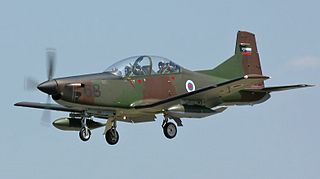
The Pilatus PC-9 is a single-engine, low-wing tandem-seat turboprop training aircraft manufactured by Pilatus Aircraft of Switzerland. Designed as a more powerful evolution of the Pilatus PC-7, the PC-9's first flight was made in May 1984 after which certification was achieved in September 1985. After this, the first production orders for the type were received from the Royal Saudi Air Force, with deliveries commencing in 1985. Since then, more than 250 airframes have been produced across five different variants, and the type is employed by a number of military and civilian operators around the world, including the Swiss Air Force, Croatian Air Force, Royal Thai Air Force and the Irish Air Corps

RAAF Base Williamtown is a Royal Australian Air Force (RAAF) military air base located 8 nautical miles north of the coastal city of Newcastle in the local government area of Port Stephens, in New South Wales, Australia. The base serves as the headquarters to both the Air Combat Group and the Surveillance and Response Group of the RAAF. The military base shares its runway facilities with Newcastle Airport. The nearest towns are Raymond Terrace, located 8 km (5 mi) west of the base and Medowie, 6.8 km (4.2 mi), north of the base, which is home to many of the base's staff.
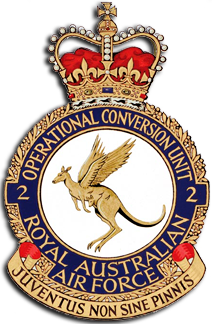
No. 2 Operational Conversion Unit is a fighter training unit of the Royal Australian Air Force (RAAF). Located at RAAF Base Williamtown, New South Wales, the unit trains pilots to operate the Lockheed Martin F-35 Lightning II. Pilots new to the F-35 enter No. 2 2OCU after first qualifying to fly fast jets at No. 79 Squadron and undertaking initial fighter combat instruction at No. 76 Squadron. Once qualified on the F-35, they are posted to one of No. 81 Wing's operational Hornet units, No. 3 Squadron, No. 75 Squadron or No. 77 Squadron.

No. 4 Squadron is a Royal Australian Air Force squadron composed of the air force special forces Combat Controllers, aircrew who operate the Pilatus PC-21 aircraft and instructors for the Australian Defence Force Joint Terminal Attack Controller (JTAC) course.

Newcastle Airport is an international airport in Williamtown, New South Wales. It is located 15 kilometres; 9.2 miles (8 NM) north of Newcastle in Port Stephens. It is the 13th busiest airport in Australia, handling over 1.25 million passengers in the year ended 30 June 2017, an increase of 6.6% on the previous year. The airport occupies a 28 ha (69-acre) site on the southern border of RAAF Base Williamtown.

No. 1 Long Range Flight was a temporary Royal Australian Air Force unit formed to participate in the 1953 London-to-Christchurch air race. The flight was established in February 1953 and was equipped with three Canberra bombers, specially modified between June and August. Following extensive training, two Canberras departed for the UK in mid-September. The race began on 9 October, and one of the flight's aircraft placed second, with a total flying time of 22 hours and 29 minutes. The other aircraft was forced out of the race when one of its tyres burst while landing at Cocos Island to refuel, but completed its flight to Christchurch after being repaired. After a brief period in New Zealand both aircraft returned to Australia to be modified back to a standard configuration, and the flight was disbanded in November.

The CAC CA-25 Winjeel is an Australian-designed and manufactured three-seat training aircraft. Entering service with the Royal Australian Air Force (RAAF) in 1955 as a basic to advanced trainer, it served in this role until 1975. Later, it was used in the Forward Air Control (FAC) role for target marking until 1994, after which it was retired from RAAF service.

The Royal Australian Air Force's Air Combat Group (ACG) is the group which administers the RAAF's fighter and bomber aircraft. ACG was formed on 7 February 2002 by merging the RAAF's Tactical Fighter Group and Strike Reconnaissance Group in an attempt to improve the speed with which the RAAF can deploy its combat aircraft.
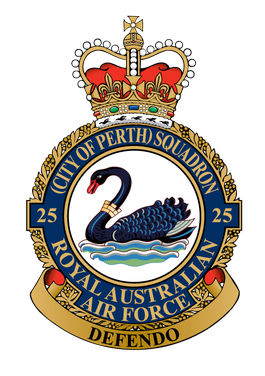
No. 25 Squadron is a general reserve squadron of the Royal Australian Air Force (RAAF). It is based at RAAF Base Pearce in Perth, Western Australia, and forms part of the Combat Support Group. The squadron was formed in early 1937 and until early 1939 was designated as No. 23 Squadron. During World War II, it provided local air defence for the Perth region, before undertaking Army co-operation duties in 1943–1944 and then converting to a heavy bomber role in 1945. Flying B-24 Liberators, the squadron took part in operations against Japanese targets in the Netherlands East Indies (NEI) and supported Allied ground operations during the Borneo Campaign.
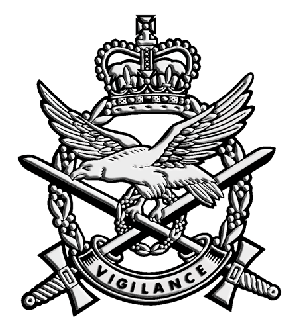
The Australian Army Aviation (AAAvn) is an administrative corps of the Australian Army. It was formed on 1 July 1968. The motto of the Australian Army Aviation corps is Vigilance.

The CAC Sabre, sometimes known as the Avon Sabre or CA-27, is an Australian variant of the North American Aviation F-86F Sabre fighter aircraft. The F-86F was redesigned and built by the Commonwealth Aircraft Corporation (CAC). Equipping five RAAF squadrons, the type saw action in the Malayan Emergency in the late 1950s, and was employed for air defence in Malaysia and Thailand in the 1960s. Ex-RAAF models also saw service with the Royal Malaysian Air Force and the Indonesian Air Force.

The Royal Australian Air Force (RAAF) operated McDonnell Douglas F/A-18 Hornet fighter aircraft between 1984 and 2021. The Australian Government purchased 75 A and B variants of the F/A-18 in 1981 to replace the RAAF's Dassault Mirage III fighters. The Hornets entered service with the RAAF between 1984 and 1990. Four Hornets were destroyed in flying accidents during the late 1980s and early 1990s.
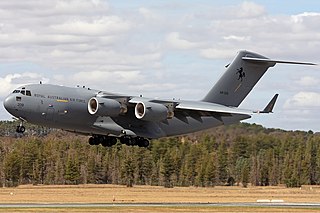
The Royal Australian Air Force (RAAF) operates eight Boeing C-17 Globemaster III large transport aircraft. Four C-17s were ordered in mid-2006 to improve the ability of the Australian Defence Force (ADF) to operate outside Australia and its region. The aircraft entered service between November 2006 and January 2008, the second pair being delivered ahead of schedule. Two more Globemasters were ordered in 2011, the sixth being delivered to the RAAF in November 2012. Another two C-17s were ordered in October 2014, with the final aircraft being delivered in November 2015. The Globemasters are built to the same specifications as those operated by the United States Air Force (USAF), and the Australian aircraft are maintained through an international contract with Boeing.

No. 1 Aircraft Depot (No. 1 AD) was a maintenance unit of the Royal Australian Air Force (RAAF). Formed in July 1921 at RAAF Point Cook, Victoria, it relocated to the nearby RAAF Laverton in March 1926. As well as servicing aircraft and other equipment, in its early years the depot supported survey flights in Australia and the Pacific region. It was also responsible for training maintenance staff.
The Development and Test Wing (DTWG) of the Royal Australian Air Force's Air Warfare Centre (AWC) is the Australian Defence Force's central institution responsible for the supervision, planning, project management, tasking and co-ordination of activities delivered by various units.

Dassault Mirage III Australian procurement was a transaction between the French and Australian governments which led to the procurement of the French designed fixed wing jet aircraft, the Mirage III, for the Royal Australian Air Force (RAAF). In the late 1950s the Australian government announced its intention to modernize its air force with state of the art technology and the French manufacturing company Dassault won the bid over the American Lockheed when the Australian government agreed to buy over 100 Mirages at an estimated cost of AUS$193.7 million in the early 1960s.

Garry Gordon Cooper DFC is a retired airline captain and served as a fighter pilot in the Royal Australian Air Force (RAAF) attaining the rank of flight lieutenant. Cooper served on assignment with United States Air Force (USAF) as a Forward Air Controller (FAC) in South Vietnam. Whilst working as a FAC in 1968, he was assigned to support the US Army's 9th Infantry Division. For his actions in Vietnam, Cooper was presented the USAF Air Force Cross which is awarded for acts of extraordinary heroism.

Lockheed Martin Australia is a wholly owned subsidiary of Lockheed Martin Corporation, with 1,200 local staff. It is one of the largest suppliers of materiel, technology, services and training to the Australian Defence Force. These include guided weapons, naval aviation combat systems, combat aircraft, transport aircraft and space domain awareness.





















